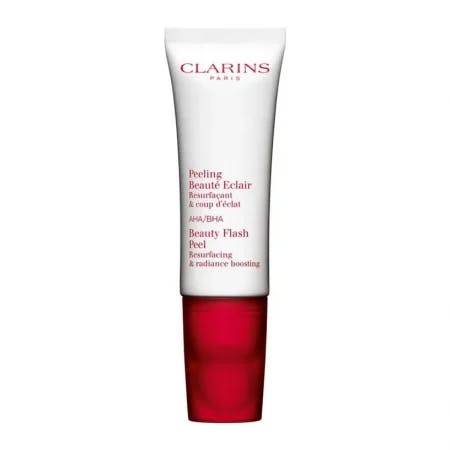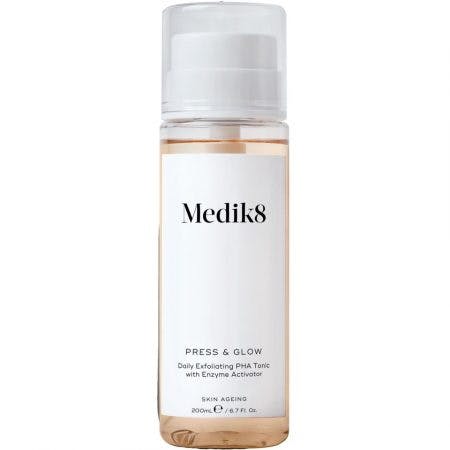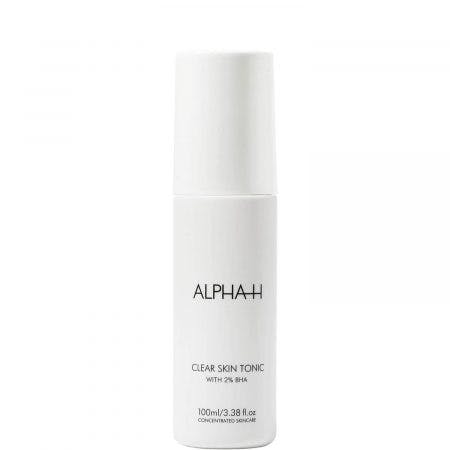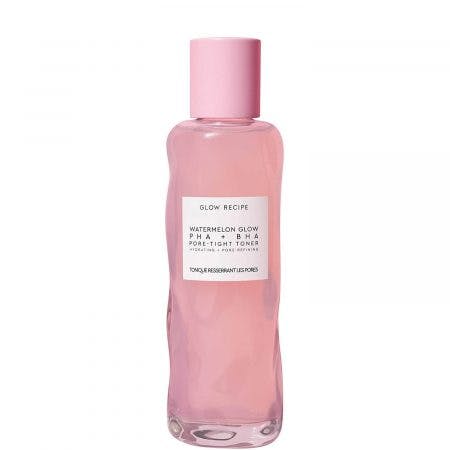Make Chemical Exfoliation A Priority If You Want Super Glowing Skin
6 minutes read
Are you looking for something that will give you instantly glowing, radiant skin, without having to put too much work in? Then it’s time you tried chemical exfoliation.
As satisfying as it may be to buff away at your skin with manual scrubs, it’s not always the best option. Especially for those with sensitive skin, as physically polishing off dead skin cells can be irritating and cause inflammation. So, what do you do if you want silky smooth, glowing skin without running the risk of leaving yourself with blotchy redness?
Invest in a chemical exfoliant and let it gently get to work on giving you the most youthful, luminous skin yet. Here, we tell you everything you need to know to find the best chemical exfoliant for your skin.
What is chemical exfoliation?
Any type of exfoliation helps to rid the skin of excess oil, dirt, sweat and dead cells — but traditionally, physical exfoliation (such as using a scrub or textured facial cloth) is the most popular option. However, chemical exfoliation can be just as effective, less time-consuming and gentler on the skin. It can also help to combat a range of skin concerns, from fine lines and acne to scarring and uneven skin colouring.
Chemical exfoliation entails applying different types of acids and enzymes to your skin. Alpha hydroxy acids (AHAs), beta hydroxy acids (BHAs) and poly hydroxy acids (PHAs) can all be used to rid your skin of dead cells and reveal a brighter, more glowing appearance.
Skincare acids work by penetrating the top layers of the skin to dissolve the ‘glue’ that bonds dead skin cells together. Dead skin cells then come loose from the skin and can be swept away, revealing a fresher base.
Some of the most popular chemical exfoliants are glycolic acid (an AHA), lactic acid (AHA) and salicylic acid (a BHA). For acne and blemish-prone skin, salicylic acid is a good option — or for dry, flaky skin and fine lines, glycolic or lactic acids both help to boost collagen and moisture levels in the skin. It is also the chemical exfoliant of choice in foot peels, to remove dry, thickened skin, but only apply a salicylic acid foot peel on skin that is whole, without cracks or irritation.

Chemical vs physical exfoliation
As we now know, there are two different types of exfoliant. But which one is best for you? When deciding which method of exfoliation to use, it’s important to take your skin type and sensitivity into consideration.
Physical exfoliants
Physical exfoliants tend to come in scrub form. These scrubs are usually made up of small particles, such as salt, sugar or ground coffee, and are a very effective way of buffing away dry skin and debris. These exfoliating ingredients can be very effective in brightening the skin and are very effective on body skin when trying to eliminate cellulite or keratosis pilaris (those small goosebumps that don’t seem to budge from your skin!).
However — if used incorrectly or too much, physical scrubs can cause sensitivity and inflammation, as they can make micro-tears in the skin from being too abrasive. They are also too strong to be used daily and should only be used three times a week at most.
Chemical exfoliants
If you suffer from sensitive, dry, uneven or sun-damaged skin, you might want to reach for a natural chemical exfoliant. They don’t tend to penetrate the skin as deeply as mechanical scrubs, nor do they cause the micro tears that physical scrubs can.
They are less abrasive on the skin and can treat a plethora of skin concerns, as well as help acne and blemish-prone skin. “Chemical exfoliants are good for acne and blemish-prone skin, as they enter the pores and help to break down grime and congestion,” says aesthetician Shane Cooper. “They are also better for those with sensitive skin as physical exfoliants can be quite harsh and potentially cause soreness,” he adds.
How to use chemical exfoliators
According to Cooper, skincare acids can be incorporated into your daily skincare regime. “Lactic, glycolic and salicylic acids are gentle enough to use daily, as most at-home products tend to contain a smaller concentration of the ingredient,” he says. “I use acids frequently in my clinic on a professional level, but here the concentrations are much higher and therefore can only be applied to the skin occasionally,” Shane adds. It’s advisable to start slowly when you are first trying out a chemical exfoliant — twice a week at first and gradually increasing use to once a day.
After cleansing, soak a cotton pad in your chemical exfoliant of choice. Then, sweep the product across your face avoiding the eye area. A gentle tingle is normal upon application — however, if it feels overwhelming, quickly swipe the product off with some water.
Chemical exfoliant toners do not need to be removed, and you can follow up with a serum, moisturizer and eye cream. Ideally, only apply chemical exfoliants at night (your skin is extra-sensitive after using them, so immediate sun exposure is ill-advised), and always remember to apply SPF daily. This also allows the most amount of time for the serum to work on tougher areas of skin. Some chemical exfoliants are applied as ‘peels’ — or masques — and need to be washed off after a specified amount of time.
Chemical exfoliators to look out for
Clarins Beauty Flash Peel, £38
For the best chemical exfoliant masque, the Beauty Flash Peel is the best option. It contains AHA and BHA exfoliants (glycolic and salicylic acids) and resurfaces the skin within just 10 minutes of application.

Medik8 Press & Glow, £27
A PHA-based potion, this is a mega gentle, non-sticky offering that can be used daily — even on sensitive skin.

Alpha H Clear Skin Tonic, £39.95
This salicylic acid-based toner is ideal for acne or blemish sufferers. It also contains chamomile and arnica to soothe any redness and irritation.

Glow Recipe Watermelon Glow PHA + BHA Pore-Tight Toner, £31
To minimize the appearance of pores and deal with dullness, this chemical exfoliant is an instant saviour.

Read more: How Stretchmark Oils Can Help Tone Your Skin
FAQs
What chemical exfoliant is best?
It all depends on the skin concern you are targeting. Some exfoliating acids, such as BHAs, are better suited to oily skin types, as they tend to penetrate deeper and unclog pores. PHAs are good for reducing signs of ageing, and AHAs are good for eliminating age spots and scarring.
Is chemical exfoliation good for your skin?
Although the words ‘chemical’ or ‘acid’ may sound a little sinister, when used in skincare they are very beneficial. If used correctly, there is little long-term harm that chemical exfoliation can do to your skin — just remember to build up use gradually and stop if your skin becomes irritated or inflamed.
What is a chemical exfoliant?
The term chemical exfoliant refers to a skincare acid or substance that works on the surface of the skin to dissolve dead skin cells and unclog pores.
Is chemical exfoliation necessary?
If your skin does not agree with physical exfoliation, chemical exfoliation may be a better option for you. To maintain a healthy glow, it is advisable to exfoliate at least once per week, but you can skip it from your skincare routine altogether if you don’t feel you need it.
Can I use both physical and chemical exfoliants?
Doing this can cause unnecessary inflammation to the skin, so it’s best to stick with just one method of exfoliation — or by spacing out treatments.
Read more: Your A-Z Eye Cream Guide
Sign up for our newsletter
We will keep you in the loop for special offers, exclusive gifts and product news.

